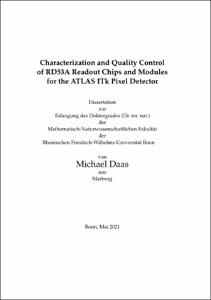Daas, Michael: Characterization and Quality Control of RD53A Readout Chips and Modules for the ATLAS ITk Pixel Detector. - Bonn, 2021. - Dissertation, Rheinische Friedrich-Wilhelms-Universität Bonn.
Online-Ausgabe in bonndoc: https://nbn-resolving.org/urn:nbn:de:hbz:5-63538
Online-Ausgabe in bonndoc: https://nbn-resolving.org/urn:nbn:de:hbz:5-63538
@phdthesis{handle:20.500.11811/9487,
urn: https://nbn-resolving.org/urn:nbn:de:hbz:5-63538,
author = {{Michael Daas}},
title = {Characterization and Quality Control of RD53A Readout Chips and Modules for the ATLAS ITk Pixel Detector},
school = {Rheinische Friedrich-Wilhelms-Universität Bonn},
year = 2021,
month = dec,
note = {In preparation of the upcoming high-luminosity upgrade of the Large Hadron Collider, the detectors of the major high-energy physics experiments at the accelerator facility will be upgraded as well. In case of the ATLAS experiment, the central tracking detector will be completely replaced. The new ATLAS Inner Tracker (ITk) is an all-silicon particle tracking detector, combining multiple layers of hybrid silicon pixel detectors and silicon strip detectors.
In this work, the prototype readout ASIC for the ITk pixel detector, RD53A, is characterized. It is the first large-scale prototype of the new generation of hybrid pixel detector readout ASICs and incorporates different flavors of digital and analog circuit design for evaluation purposes. The characterization measurements presented in this thesis reveal strengths and weaknesses of the different analog front-end flavors of RD53A that lead to the independent decisions made by ATLAS and CMS in the front-end review processes. Additionally, a wafer probing setup and test routine for quality control measurements of RD53A within the ITk pre-production program were developed in the scope of this work. With this setup, 8900 RD53A chips have been probed at multiple locations and the test results are analyzed and presented in this thesis. About 80% of all tested chips are found to be suitable for further R&D purposes within the ITk pre-production program and the unprecedented sample size allows interesting investigations of the chip's peculiarities.
Furthermore, RD53A is evaluated when bump-bonded to a sensor and the performance of the resulting module is compared to the bare chip's results, allowing more insights into the differences between the analog front-end flavors. All three implementations meet the specifications, but considerable performance differences are observed and laid out in detail. Finally, double-chip modules based on RD53A are tested extensively in the scope of the ITk hybridization market survey, in order to investigate the quality and robustness of different bump-bonding processes and to compare and evaluate the available industrial vendors. Arguments and recommendations for or against most of the available processes are presented in this thesis.},
url = {https://hdl.handle.net/20.500.11811/9487}
}
urn: https://nbn-resolving.org/urn:nbn:de:hbz:5-63538,
author = {{Michael Daas}},
title = {Characterization and Quality Control of RD53A Readout Chips and Modules for the ATLAS ITk Pixel Detector},
school = {Rheinische Friedrich-Wilhelms-Universität Bonn},
year = 2021,
month = dec,
note = {In preparation of the upcoming high-luminosity upgrade of the Large Hadron Collider, the detectors of the major high-energy physics experiments at the accelerator facility will be upgraded as well. In case of the ATLAS experiment, the central tracking detector will be completely replaced. The new ATLAS Inner Tracker (ITk) is an all-silicon particle tracking detector, combining multiple layers of hybrid silicon pixel detectors and silicon strip detectors.
In this work, the prototype readout ASIC for the ITk pixel detector, RD53A, is characterized. It is the first large-scale prototype of the new generation of hybrid pixel detector readout ASICs and incorporates different flavors of digital and analog circuit design for evaluation purposes. The characterization measurements presented in this thesis reveal strengths and weaknesses of the different analog front-end flavors of RD53A that lead to the independent decisions made by ATLAS and CMS in the front-end review processes. Additionally, a wafer probing setup and test routine for quality control measurements of RD53A within the ITk pre-production program were developed in the scope of this work. With this setup, 8900 RD53A chips have been probed at multiple locations and the test results are analyzed and presented in this thesis. About 80% of all tested chips are found to be suitable for further R&D purposes within the ITk pre-production program and the unprecedented sample size allows interesting investigations of the chip's peculiarities.
Furthermore, RD53A is evaluated when bump-bonded to a sensor and the performance of the resulting module is compared to the bare chip's results, allowing more insights into the differences between the analog front-end flavors. All three implementations meet the specifications, but considerable performance differences are observed and laid out in detail. Finally, double-chip modules based on RD53A are tested extensively in the scope of the ITk hybridization market survey, in order to investigate the quality and robustness of different bump-bonding processes and to compare and evaluate the available industrial vendors. Arguments and recommendations for or against most of the available processes are presented in this thesis.},
url = {https://hdl.handle.net/20.500.11811/9487}
}






